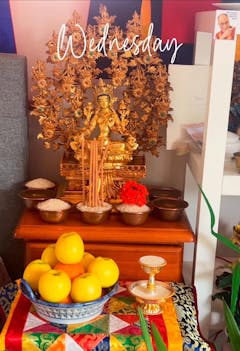Wrathful Manjushri Sculpture | Traditional Himalayan Buddhist Art
Premium Manjushri Statue | Handmade Gold Fire-Gilded Copper Sculpture
Discover Divine Wisdom with Manjushri Statue | Handicrafted in Nepal
Sacred Manjushri Statue | Oxidized Bodhisattva of Wisdom from Nepal
Premium Manjushri Meditation Statue | Handcrafted Symbol of Wisdom
Wisdom God Manjushri Statue | Traditional Nepalese Artwork
Dharma Prince Manjushri Statue | Wisdom Bodhisattva Idol for Meditation
Prince of Wisdom Manjushree Statue | Vajrayana Bodhisattva Figurine
Handcrafted Jampelyang Statue | Traditional Tibetan Buddhist Artwork
Nepalese Arapacana Manjushri Statue | Handmade Wisdom Deity Sculpture
Buddhist Manjushri Statue | Gold-Gilded Bodhisattva of Knowledge Idol
Bodhisattva of Wisdom Manjushri Sculpture | Buddhist Meditation Idol
Who is the Manjushri Statue?
Manjushri is one of the most revered Bodhisattvas in Mahayana Buddhism and Vajrayana Buddhism, symbolizing transcendent wisdom and enlightened insight. Often depicted holding a flaming sword in his right hand and a sacred scripture (Prajnaparamita Sutra) in his left, Manjushri represents the sharp clarity of wisdom that cuts through ignorance and illusion. His serene expression, holds a sword, seated posture, and radiant presence embody the balance between knowledge and compassion.
In Buddhist traditions, devotees pray to Manjushri to enhance memory, sharpen the intellect, and remove mental obstacles on the path to enlightenment. Students and seekers often chant the mantra “Om Ah Ra Pa Tsa Na Dhih” to invoke his blessings for learning and clarity.
Explore Our Hand-Carved Manjushri Statue Collection
Our hand-carved Manjushri Buddha statues are beautifully made by skilled Nepalese artisans using traditional methods passed down for generations. Manjushri, the Bodhisattva of Wisdom, is honored in Mahayana and Vajrayana Buddhism for his deep insight and his sword, which symbolizes cutting through ignorance with the power of wisdom.
Each Manjushri statue in our collection is meticulously handcrafted, often using traditional materials such as copper, oxidized copper, or fire-gilded in 24k gold, and adorned with semi-precious stones like turquoise, coral, and lapis lazuli. From his radiant facial expression to the sacred sword and lotus-holding left hand, every detail symbolizes spiritual clarity, eloquence, and enlightened understanding.
Masterful Craftsmanship of the Manjushri Statue
The craftsmanship statue of Manjushri is a sacred blend of spiritual devotion, artistic mastery, and cultural heritage. Each statue is hand-carved by skilled artisans, primarily in Nepal and Tibet, where traditional Buddhist sculpture techniques have been preserved for centuries.
These Manjushri statues are often crafted using the Lost Wax Casting method, a time-honored process that involves creating a detailed wax model, encasing it in clay, and then casting it in bronze, copper, or gold-plated metals. This method allows for intricate detailing, especially in the symbolic elements like Manjushri’s flaming sword of wisdom, the lotus flower, and his peaceful, meditative expression.
🛡️ How to Care for a Gold-Gilded Manjushri Statue
-
Handle with clean hands – Avoid touching the gold parts too much.
-
Keep away from water – Don’t wash or wipe with a wet cloth.
-
Dust gently – Use a soft, dry cloth or brush to clean it.
-
Avoid sunlight & heat – Keep it in a cool, dry place, away from direct sun or heaters.
-
Don’t use chemicals – Never use sprays, polish, or cleaners.
-
Use a display case – If possible, protect it in a glass or acrylic box.
-
No jewelry while cleaning – Rings or bracelets can scratch the surface.
Why Choose a Manjushri Statue?
-
Symbol of Wisdom: Manjushri represents supreme knowledge and clarity of mind.
-
Cuts Through Ignorance: His flaming sword symbolizes removing illusion and confusion.
-
Enhances Study & Focus: Ideal for students, teachers, and meditation practitioners.
-
Spiritual Growth: Encourages inner strength, insight, and enlightened thinking.
-
Meaningful Decor or Gift: A sacred and thoughtful addition to any home or altar.
Mantra of Manjushri Statue
Manjushri mantra statue, Manjushri the Bodhisattva of Wisdom, is deeply revered in Buddhism for embodying enlightened intelligence, clarity, and profound insight. His mantra is chanted to enhance wisdom, sharpen the mind, and remove ignorance.
Mantra:
"Om Ah Ra Pa Tsa Na Dhih"
Meaning & Benefits:
-
Om – The sacred syllable invoking universal energy.
-
Ah Ra Pa Tsa Na – These syllables represent the essence of profound wisdom and are said to contain the entire teachings of the Prajnaparamita (Perfection of Wisdom).
-
Dhih – A seed syllable that embodies wisdom and mental clarity.
Explore now to bring Manjushri’s timeless wisdom and serenity into your life. Let his presence guide your journey to enlightenment.






































































